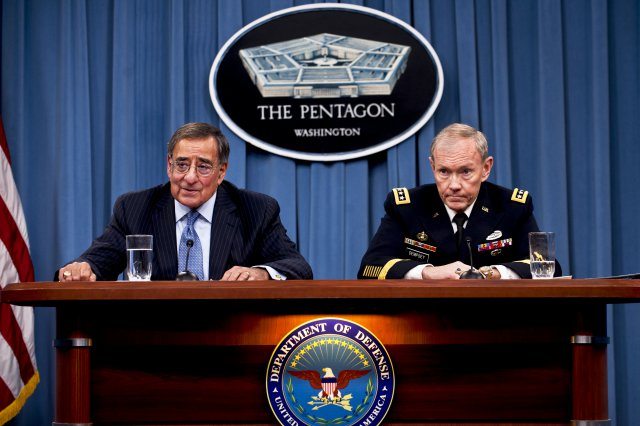Spending priorities in the forthcoming fiscal year 2013 defense budget request call for reductions in the end strength of the Army and Marine Corps, an increase in special operations forces and maintaining the number of big-deck carriers, Defense Secretary Leon E. Panetta said here today.
The Pentagon’s budget topline request is set at $525 billion for fiscal 2013 with an additional $88.4 billion for overseas contingency operations — mostly in Afghanistan. This is down from $531 billion and $115 billion, respectively, in this fiscal year.
Defense Department officials used the new defense strategy guidance that President Barack Obama announced earlier this month to shape the budget request, the secretary said.
The budget seeks to minimize the impact of cuts on personnel accounts. Service members will receive their full pay raises in fiscal 2013 and 2014, Panetta said. “We will achieve some cost savings by providing more limited pay raises beginning in 2015,” he added.
Health care is another important benefit, and one that has far outpaced inflation. Changes to health care will not affect active duty personnel or their families, Panetta said.
“We decided that to help control growth of health care costs, we are recommending increases in health care fees, co-pays and deductibles for retirees,” he said. “But let me be clear that even after these increases, the cost borne by military retirees will remain below the levels in comparable private-sector plans.”
Overall, the request puts DOD on the path to save $259 billion over the next five years and $487 billion over the next 10. Panetta called the budget “a balanced, complete package” that keeps the American military the pre-eminent force in the world.
It is a balanced package, the secretary said, because while some programs are eliminated or delayed, others are increased. The budget looks to re-shape the military to be more agile, quick and flexible that incorporates the lessons learned in 10 years of war, he added.
Increasing the number of special operations forces is key to the plan, Panetta said, and special operators will begin to shift back to their traditional pre-9/11 mission of instructing local forces.
The request puts the Army on a path to drop to 490,000 soldiers and the Marine Corps to 182,000 Marines over five years. Currently, the two services have 562,000 and 202,000 active-duty members, respectively. The secretary noted this is still higher than the numbers on 9/11.
The budget treats the reserve components very carefully, Panetta said. After a decade of being an integral part of America’s wars, the reserve components will not go back to being a strategic Cold War-era reserve. The reserves will be the nation’s hedge against the unexpected, the secretary said.
“We are making only marginal reductions in the Army Reserve and Army National Guard, and no reductions in the Marine Corps Reserve,” the secretary said. “The Air Force will make balanced reductions in the Air Guard that are consistent with reductions in the active component and Air
Force Reserve.”
The request also calls for more base realignments and closures, and a “BRAC-like” authority to recommend changes to military retirement. “But the president and department have made clear that the retirement benefits of those who currently serve will be protected by grandfathering their benefits,” Panetta said.
The budget maintains the current U.S. focus in the Central Command region and increases American commitment to the Pacific Command area of operations. The request looks to maintain the Navy’s current 11 aircraft carriers and 10 carrier air wings, Panetta said. It will also maintain the current Marine and Army posture in the Asia-Pacific region, and will base littoral combat
ships in Singapore and Bahrain.
The budget will eliminate two forward-based Army heavy brigades in Europe. Instead, brigades will rotate in and out of the area. The United States and European allies also will look to share costs for new capabilities such as the alliance ground surveillance program.
The Navy will retire seven older cruisers and two amphibious ships early, and the Air Force will eliminate six tactical air squadrons.
The budget sinks more money into technologies to prevail in an anti-access, aerial-denial scenario and will fund the next-generation bomber and modernization of the submarine fleet.
The F-35 joint strike fighter is key to maintaining domain superiority, and the military remains committed to the program, Panetta said. “But in this budget, we have slowed procurement to complete more testing and allow for developmental changes before buying in significant quantities,” he added.
The budget will maintain all legs of the nuclear triad — bombers, ICBMs and submarines — and will invest in significantly more capability in the cyber world, Panetta said.
Panetta stressed the budget is based on strategy and will shape the force for the future. While the pain of cuts will be felt across the country, he said, it will also ensure a strong, agile military for the future.
The budget must pass Congress, and the secretary said he hopes members of Congress understand the strategy and nuances of the budget.
“My hope is that when members understand the sacrifice involved in reducing the defense budget by half a trillion dollars, it will convince Congress to avoid sequestration, a further round of cuts that would inflict severe damage to our national defense for generations,” Panetta said.










